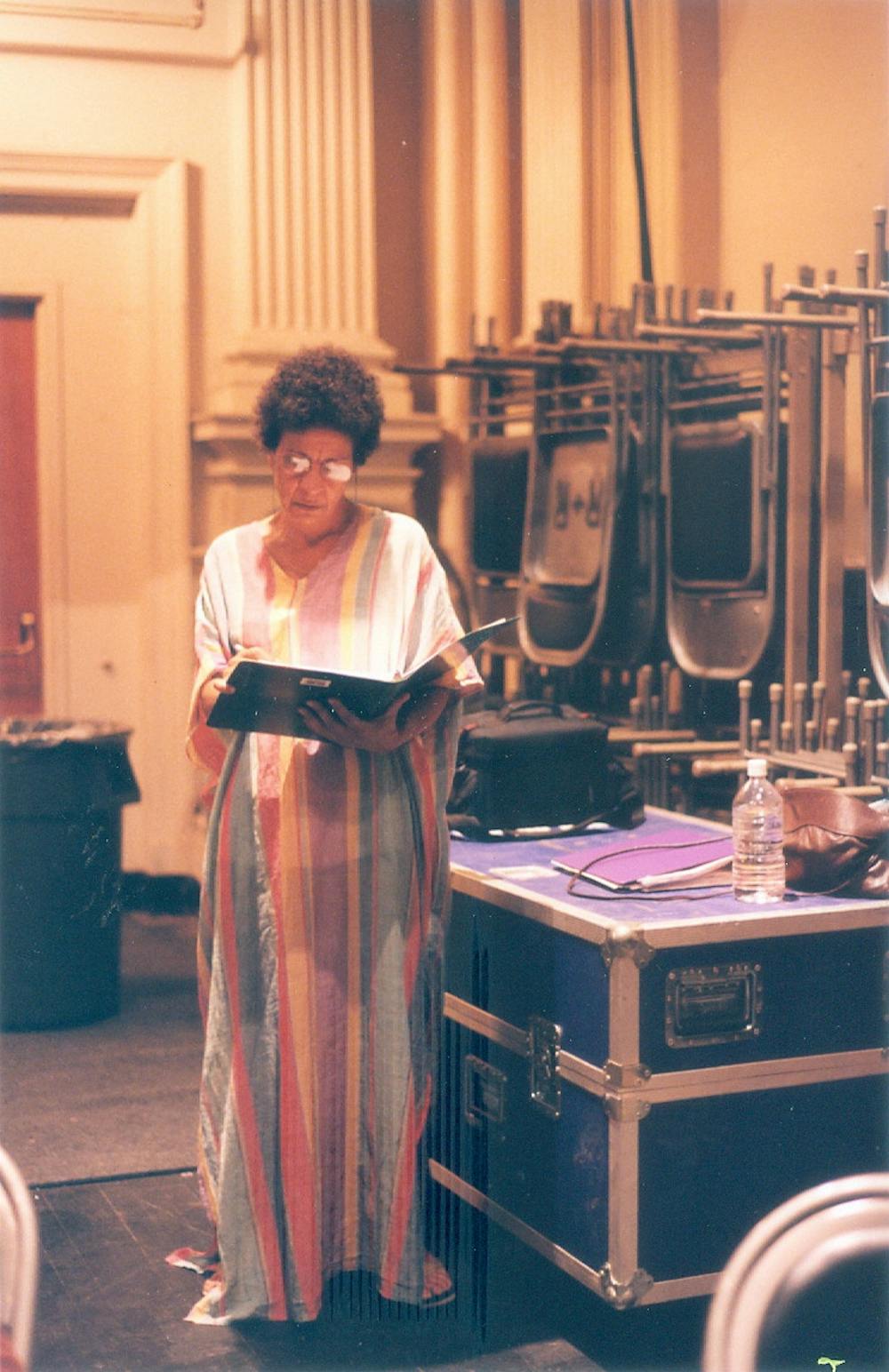At his office desk in Churchill House, Elmo Terry-Morgan ’74, associate professor of Africana Studies and Theater Arts and Performance Studies, rapidly types away at a computer which spouts music and voice clips right back at him.
Every inch of his office is covered with pieces of Rites and Reason Theatre history. A multi-colored couch is littered with posters for the 2018 “Black Lavender Experience.” His walls are adorned with pictures of now-passed friends and idols, including a family portrait of George Houston Bass. Boxes of unexplored theater history sit beneath his L-shaped desk.
Terry-Morgan is the artistic director at the Rites and Reason Theatre, a five-decade-old space created to “express the cultural, social, and ideological concerns of the African Diaspora,” according to the Department of Africana Studies website.
To be part of something as historic as the Rites and Reason Theatre “is surreal,” Terry-Morgan said.
The theater’s inception
In December 1968, University students held the Black Student Walkout, demanding increased enrollment of Black students and increased hiring of Black faculty. As a result, the University recruited Professor George Houston Bass, the former personal secretary of Langston Hughes and the executor of his estate, to head up the newly created Africana Studies Department.
When Bass arrived at the University in 1970, he began to cultivate a new form of theater. He worked with “New World Theater, anchored in Africanic experiences and perspectives,” Terry-Morgan said. He “was a folklorist … He wrote in jazz styles, blues styles, gospel styles. He began validating African American culture and traditions.”
In the spring of 1971, following several theater workshops, Bass debuted his play “Black Masque,” a naturalistic play depicting the cosmic dance between Black and white people. This became the first official Rites and Reason project, garnering attention from the University and allowing the theater to become an official academic unit in the embryonic Africana Studies department.
Historical hurdles
Despite the theater’s influence and ground-breaking, experimental methods, it has faced many hurdles. “Being at Brown has been sometimes, many times, a great blessing, but sometimes a great challenge,” Terry-Morgan said.
Throughout the theater’s history it has had to look for funding beyond the University through the likes of the National Endowment for the Arts and the Black Heritage Society. This was especially prevalent in the 1990s, when a national assault on the arts left many “non-mainstream” theaters — including “Black theaters, Latinos, Asian, queer and women’s groups” — budgetless, Terry-Mogan said.
Until 2001, the theater was unable to hire any permanent staff like technical directors or production managers.
“We used to bring in our friends who did this work, and they’d work for peanuts. We didn’t even have money to house them, so they stayed with us.” Terry-Morgan said. “These people worked here because they believed in what we were doing.”
The theater also faced infrastructure problems, including non-fire-resistant curtains, bad wiring and poor electrical circuits. The University’s attitude “wasn’t benign neglect; it was benign attention,” Terry-Morgan said. It was like “we’ll give you just enough to stay alive, but we’re not going to give you a budget.”
Finding solace in the community
Despite these difficulties, the theater persevered and found strength in support from Brown students. In the 1990s, when Terry-Morgan began working as the theater’s artistic director, the University’s student population was becoming increasingly diverse.
“There were more people from every part of the world,” Terry-Morgan said. “They have interest in the work that Rites and Reason does … so I said, I’m not going to turn these students away.”
As a result, the theater expanded its work beyond the Black experience, producing works dealing with Jewish soldiers in Czarist Russia, the multi-generational history of Hawaii and foot-binding in China.
Terry-Morgan said one of his proudest accomplishments was teaching AFRI 0990: “Black Lavender: Black Gay/Lesbian Plays/Dramatic Constructions in the American Theatre,” a course and theater program that explored Black LGBTQ content and was one of the first of its kind in the nation.
“My course was on a hit list. … (People) will scour course catalogs at the universities, looking for what they consider to be inappropriate content, and they make a list and my class got on it,” Terry-Morgan said. “I took it as a badge of honor.”
The theater’s effect reached beyond Brown, developing a profound connection with the Providence community.
Alonzo Jones, technical director and manager of the theater, cited a personal and familial connection to Rites and Reasons. “I grew up here in Providence ... I worked at (the) Providence Black Repertory Company. Before that, I worked at the Trinity Repertory Company. I worked at all the local theaters. So, you’d be able to borrow from theaters all over.”
For Terry-Morgan, the play “Heart to Heart: Ain’t Your Life Worth Saving?” is one of the greatest examples of the theater’s effect on the Providence community. The play came from a collaboration between Terry-Morgan and the New England affiliate of the American Heart Association to address the leading cause of death among Black women — heart attacks and strokes. The play was performed in the community on a moving stage and assemblable set. The show traveled hand-in-hand with medically licensed professionals who would give audience members check-ups before and after the show and help connect them with any necessary resources.
Six months later, a “follow-up” conducted by the University’s linguistics department showed that “many people had made lifestyle changes” after seeing the show, Terry-Morgan said. “Some said … ‘I’m gonna quit smoking’ … ‘I’m more conscious of the food I buy, I read labels’ ... These things show that the arts could actually impact people’s lives.”
In honor of the theater’s fiftieth anniversary, which was in 2020, a series of programming titled “Fifty Years and Beyond” is in development. Led by Lisa Biggs, professor of the arts and Africana studies, the program’s first performance will be a retrospective of a previous play, “The Providence Garden Blues,” in conjunction with the Brown-Trinity MFA Program.
The performance focuses on the thriving middle-class Black community around the University campus that was displaced following World War II because of urban renewal.
Biggs reflected that many of the topics discussed in this performance are still very relevant today.
“This show is a chance to think back on this moment years ago when students and faculty and local community leaders were navigating these issues, and for us to continue to think about them and imagine ways also to tell the story about this need in ways that are artistic,” Biggs said.
A new spotlight
Many of the conversations happening today, including the recent importance of the Black Lives Matter movement in the public consciousness, have led to the theater garnering more attention from the University.
“All of a sudden, the atmosphere on campus shifted,” Terry-Morgan said. “Brown was in the middle of the diversity, inclusion and equity initiative and then the creation of the Brown Arts Initiative. That was major for us — we were able to get attention from other people on campus who work in the arts.”
In December 2019, after the ceiling caved in at Churchill House, where the Rites and Reason Theatre is located, the University finally allotted a proper budget to the theater, according to Terry-Morgan. Renovations for the whole building will soon be underway.
For Kathy Moyer, stage and production manager at the Department of Africana Studies and Rites and Reason Theatre, the most important goal is getting the department recognized as an arts department. “We’re always trying to be heard, … whether it’s to be recognized as an arts department on the campus, or to be seen as a viable theater that needs the resources that the other theaters and arts departments are getting.”
Today, the theater is amidst a major archival project, going through five decades worth of documentation to create a massive online resource at the John Hay Library.
“My main goal is really to get the archives functioning so that there is a system that’s in place,” Terry-Morgan said. “When I am retired and long gone, when I’m in heaven, I want to watch all of this still be going on … That’s the legacy that I want to leave behind.”

Alex Nadirashvili was the managing editor of multimedia and social media for The Brown Daily Herald's 133rd Editorial Board. As a former University News editor, he covered faculty, higher education and student life, though his proudest legacy is The Brown Daily Herald TikTok account.





